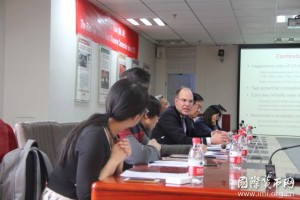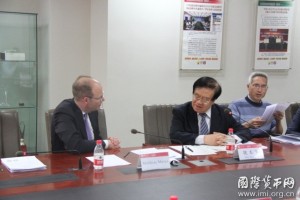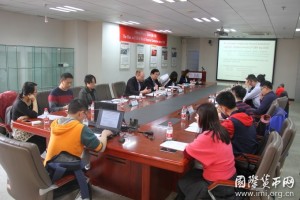Macro-Finance Salon (No. 54): The Rise and Fall of World Reserve Currencies since 1870
2017-04-12 IMI Professor Morys reviewed the evolution and development of the world reserve currency since 1870. He mentioned that the dollar has been the dominant currency since the 1960s, and after 1999, the euro had posed a threat on the dollar's dominance, and then the euro's momentum had fallen as a result of the euro crisis. In recent years, China's economy continues to grow, coupled with the central bank’s active promotion of the internationalization of the renminbi, the renminbi has gradually become the most potential opponent of the dollar. However, it has never been possible for a country's currency to catch up with another country's overnight. In general, the stronger the spillover of the dominant currency, the harder it is to shake its position. Historically, US GDP had surpassed Britain in 1870, but the dollar hadn’t replaced the pound until 1960; the gold standard dominated Europe in 1870, but was not abandoned until after World War II. Therefore, the dollar’s position will be difficult to change for a long period of time. Professor Morys elaborated on the three historical stages of the gold standard, which were the classical gold standard (1870-1914), the gold standard (1925-1931) during the two World Wars, and the Bretton Woods system (1944-1971/73). In this process, as the status of foreign exchange reserves is getting higher, central banks gradually replaced foreign exchange as a reserve for gold. Yet, the status of different currencies as foreign exchange reserves are significantly different, and this contrast has changed with the rise and fall of countries’ national strength. Before WW I, the United Kingdom, as the first to carry out industrial revolution, enjoyed the highest gross national product. It is the world's largest trading nation with a sustained trade surplus. The status of the pound rose with the rising economy, and thus became the dominant currency. Professor Morys pointed out that when a country's currency becomes the dominant currency, it means that the country is bound to be a financial center and has strong political power.
Professor Morys specifically referred to the gradual abandonment of the gold standard and the reasons. He used the example of, dollar’s replacement of the British pound from 1914 to 1924to illustrate the fast changing nature of the current monetary system. There may be several currencies coexist, and there may be differences between various regions. He also said that issuance of reserve currency has both pros and cons for a country. On the one hand, it is conducive to grasp the dominance of the trade and monetary policies. On the other hand, it bears the responsibility of mobility and stability, and guarding against risks.
Professor Morys reviewed the evolution and development of the world reserve currency since 1870. He mentioned that the dollar has been the dominant currency since the 1960s, and after 1999, the euro had posed a threat on the dollar's dominance, and then the euro's momentum had fallen as a result of the euro crisis. In recent years, China's economy continues to grow, coupled with the central bank’s active promotion of the internationalization of the renminbi, the renminbi has gradually become the most potential opponent of the dollar. However, it has never been possible for a country's currency to catch up with another country's overnight. In general, the stronger the spillover of the dominant currency, the harder it is to shake its position. Historically, US GDP had surpassed Britain in 1870, but the dollar hadn’t replaced the pound until 1960; the gold standard dominated Europe in 1870, but was not abandoned until after World War II. Therefore, the dollar’s position will be difficult to change for a long period of time. Professor Morys elaborated on the three historical stages of the gold standard, which were the classical gold standard (1870-1914), the gold standard (1925-1931) during the two World Wars, and the Bretton Woods system (1944-1971/73). In this process, as the status of foreign exchange reserves is getting higher, central banks gradually replaced foreign exchange as a reserve for gold. Yet, the status of different currencies as foreign exchange reserves are significantly different, and this contrast has changed with the rise and fall of countries’ national strength. Before WW I, the United Kingdom, as the first to carry out industrial revolution, enjoyed the highest gross national product. It is the world's largest trading nation with a sustained trade surplus. The status of the pound rose with the rising economy, and thus became the dominant currency. Professor Morys pointed out that when a country's currency becomes the dominant currency, it means that the country is bound to be a financial center and has strong political power.
Professor Morys specifically referred to the gradual abandonment of the gold standard and the reasons. He used the example of, dollar’s replacement of the British pound from 1914 to 1924to illustrate the fast changing nature of the current monetary system. There may be several currencies coexist, and there may be differences between various regions. He also said that issuance of reserve currency has both pros and cons for a country. On the one hand, it is conducive to grasp the dominance of the trade and monetary policies. On the other hand, it bears the responsibility of mobility and stability, and guarding against risks.
 In the comment section, Mr. Wei Benhua pointed out that the evolution of the international reserve currency provides a good reference for renminbi. He agrees with Professor Morys that the status of a country's currency is supported by the country's economic strength. China is the world's second largest economy and the largest developing country with a population that is several times larger than that of the United States. China maintains growth momentum. In this case, the renminbi has the potential to play a greater role and more important role. However, the RMB internationalization is anything but seeking hegemony. The yuan can coexist with other currencies. The dollar spent more than half a century before it could rival the pound. There is still a long way to go before the yuan becomes the world's leading currency.
In the comment section, Mr. Wei Benhua pointed out that the evolution of the international reserve currency provides a good reference for renminbi. He agrees with Professor Morys that the status of a country's currency is supported by the country's economic strength. China is the world's second largest economy and the largest developing country with a population that is several times larger than that of the United States. China maintains growth momentum. In this case, the renminbi has the potential to play a greater role and more important role. However, the RMB internationalization is anything but seeking hegemony. The yuan can coexist with other currencies. The dollar spent more than half a century before it could rival the pound. There is still a long way to go before the yuan becomes the world's leading currency.
 Subsequently, Mr. Sun Lujun reviewed the internationalization of the RMB, pointing out that the RMB has achieved a series of major institutional changes, including cross-border settlement, offshore market development, bilateral exchange, and has joined the SDR. He believes that the renminbi has made substantial progress this year, but it is also faced with challenges. International reserve currency requires interest rate marketization, exchange rates flexibility, capital account convertibility and macro prudential management. These are all that China needs to work on. The RMB will be a strong opponent of the dollar, but it will not surpass the dollar in the near future.
Subsequently, Mr. Sun Lujun reviewed the internationalization of the RMB, pointing out that the RMB has achieved a series of major institutional changes, including cross-border settlement, offshore market development, bilateral exchange, and has joined the SDR. He believes that the renminbi has made substantial progress this year, but it is also faced with challenges. International reserve currency requires interest rate marketization, exchange rates flexibility, capital account convertibility and macro prudential management. These are all that China needs to work on. The RMB will be a strong opponent of the dollar, but it will not surpass the dollar in the near future.

